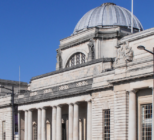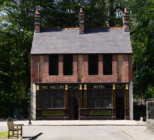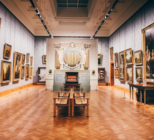A reintrepreted portrait of slave owner Sir Thomas Picton has put back on display at National Museum Cardiff, alongside two new artist commissions which are hoped to reframe the legacy of the Welsh officer of the British Army.
The portrait was removed last November from the ‘Faces of Wales’ gallery at National Museum Cardiff, ahead of a new youth-led initiative to reinterpret the painting.
Portrait of Picton removed from National Museum Cardiff prior to reinterpretation
Lieutenant-General Sir Thomas Picton’s portrait will return to the museum’s walls in a travel frame following its removal in November 2021. The portrait by Sir Martin Archer Shee has been a part of Amgueddfa Cymru’s collections since its founding in 1907.
The accompanying two new commissions include an immersive installation of sculpture, objects from the Amgueddfa Cymru collections, photographs and film, which will become part of Wales’ national collection. The commissions are hoped to give a voice to those most affected by Picton’s actions, and to those who live with the legacy today.
The commissions follow a callout by Amgueddfa Cymru in January 2021 for artists to explore alternatives to the colonial narrative represented by the portrait of Lieutenant-General Sir Thomas Picton and to centre Black experiences.
The decision to reinterpret the portrait was made as part of Reframing Picton – a youth-led project team involving the SSAP Youth Leadership Network and the Amgueddfa Cymru Producers.
The project team worked with the museum’s curators to provide additional information and context about Picton’s legacy as Governor of Trinidad at the turn of the 19th century. This includes his brutal treatment of the people of Trinidad, including the torture of 14-year-old Luisa Calderon – information which was not part of the museum’s previous interpretation of the portrait.
The Reframing Picton project team explained: “One of our goals for this exhibition was to create a site of conscience rather than indoctrination. To create a dialogue between museums, the governments that fund them and the communities they serve. To create healthy ways of addressing trauma. We hope that this exhibition will encourage visitors of all backgrounds to listen and learn from the past, and to put these learnings into practice today.”
Artists Gesiye (pronounced gay-see-yay) was commisioned to create “The Wound is a Portal”, which uses the process of tattooing to explore generational trauma, and includes a series of portraits and a short film.
Gesiye said: “I’m grateful to have created this work in collaboration with musicians, designers, filmmakers, photographers and eight volunteers from across the island who met through this experience.”
Artistic group Laku Neg (Black Yard in Haitian Kwéyòl) is represented by four artists, three of Trinidadian heritage, who live and work in the UK and promote expressions of African diaspora knowledge through the arts.
Laku Neg’s commission ‘Spirited’ is an immersive installation comprising a metal sculpture, bamboo frames, twisted paper, found objects and audio visual elements which explores a re-presentation of Luisa, Thisbe and Present, named victims of Picton’s brutal regime in Trinidad.
Laku Neg said: “Here, we offer re-imaginings and re-creations of a period in which Trinidadian and Welsh history overlap. It is art borne of our imagination; it is motivated by experience and informed by, not responding to, history. It bears the fingerprints of communities of supporters in Trinidad and in Wales, who all helped to realise a vision that originated in our yard.”
The project is the culmination of work between Amgueddfa Cymru and the Sub Sahara Advisory Panel’s (SSAP) Youth Leadership Network and the Amgueddfa Cymru Producers.
Fadhili Maghiya, Director at the Sub Sahara Advisory Panel addressed the potential for the group’s work to be interpreted as “rewriting history”. Maghiya said that the project instead “aims to rewrite our future by challenging the way we engage with history. The project enables us to widen the spotlight that has for many years hidden the darkness of Picton in all its full and truthful context.”
“For the longest time Picton has been celebrated in Wales, now, for the first-time communities that were historically exploited and abused by the likes of Picton have a reason to celebrate”.
Minister for Social Justice Jane Hutt said of the project: “Amgueddfa Cymru belongs to everyone and is here for everyone to use. We are a charity and a family of seven national museums and a collections centre, located across the country. Our aim is to inspire everyone through Wales’ story, at our museums, in communities and digitally.”










